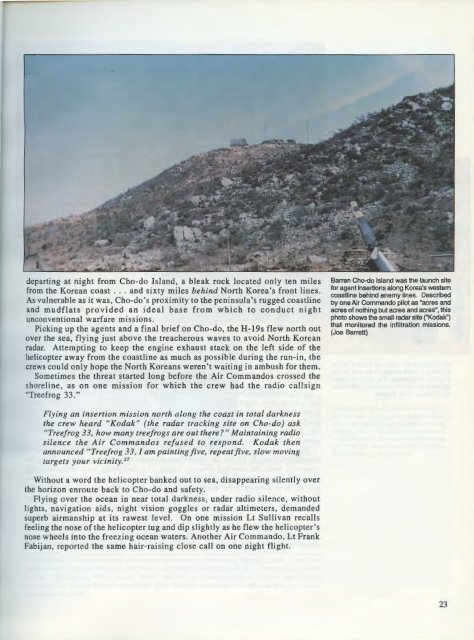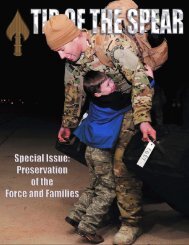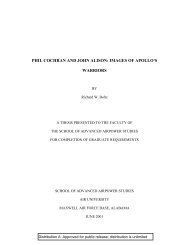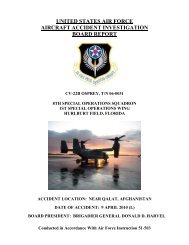Air Commando!: 1950-1975 - Twenty-five years at the Tip ... - AFSOC
Air Commando!: 1950-1975 - Twenty-five years at the Tip ... - AFSOC
Air Commando!: 1950-1975 - Twenty-five years at the Tip ... - AFSOC
You also want an ePaper? Increase the reach of your titles
YUMPU automatically turns print PDFs into web optimized ePapers that Google loves.
departing <strong>at</strong> night from Cho-do Island, a bleak rock loc<strong>at</strong>ed only ten miles<br />
from <strong>the</strong> Korean coast .. . and sixty miles behind North Korea's front lines.<br />
As vulnerable as it was, Cho-do's proximity to <strong>the</strong> peninsula's rugged coastline<br />
and mudfl<strong>at</strong>s provided an ideal base from which to conduct night<br />
unconventional warfare missions.<br />
Picking up <strong>the</strong> agents and a final brief on Cho-do, <strong>the</strong> H-19s flew north out<br />
over <strong>the</strong> sea, flying just above <strong>the</strong> treacherous waves to avoid North Korean<br />
radar. Attempting to keep <strong>the</strong> engine exhaust stack on <strong>the</strong> left side of <strong>the</strong><br />
helicopter away from <strong>the</strong> coastline as much as possible during <strong>the</strong> run-in, <strong>the</strong><br />
crews could only hope <strong>the</strong> North Koreans weren't waiting in ambush for <strong>the</strong>m.<br />
Sometimes <strong>the</strong> thre<strong>at</strong> started long before <strong>the</strong> <strong>Air</strong> <strong>Commando</strong>s crossed <strong>the</strong><br />
shoreline, as on one mission for which <strong>the</strong> crew had <strong>the</strong> radio callsign<br />
"Treefrog 33."<br />
Barren Cho-do Island was <strong>the</strong> launch site<br />
for agent insertions along Korea's western<br />
coastline behind enemy lines. Described<br />
by one <strong>Air</strong> <strong>Commando</strong> pilot as "acres and<br />
acres of nothing but acres and acres", this<br />
photo shows <strong>the</strong> small radar site ("Kodak")<br />
th<strong>at</strong> monitored <strong>the</strong> infiltr<strong>at</strong>ion missions.<br />
(Joe Barrett)<br />
Flying an insertion mission north along <strong>the</strong> coast in total darkness<br />
<strong>the</strong> crew heard "Kodak" (<strong>the</strong> radar tracking site on Cho-do) ask<br />
"Treefrog 33, how many treefrogs are out <strong>the</strong>re?" Maintaining radio<br />
silence <strong>the</strong> <strong>Air</strong> <strong>Commando</strong>s refused to respond. Kodak <strong>the</strong>n<br />
announced "Treefrog 33, I am painting <strong>five</strong>, repe<strong>at</strong> <strong>five</strong>, slow moving<br />
targets your vicinity. 27<br />
Without a word <strong>the</strong> helicopter banked out to sea, disappearing silently over<br />
<strong>the</strong> horizon enroute back to Cho-do and safety.<br />
Flying over <strong>the</strong> ocean in near total darkness, under radio silence, without<br />
lights, navig<strong>at</strong>ion aids, night vision goggles or radar altimeters, demanded<br />
superb airmanship <strong>at</strong> its rawest level. On one mission Lt Sullivan recalls<br />
feeling <strong>the</strong> nose of <strong>the</strong> helicopter tug and dip slightly as he flew <strong>the</strong> helicopter's<br />
nose wheels into <strong>the</strong> freezing ocean w<strong>at</strong>ers. Ano<strong>the</strong>r <strong>Air</strong> <strong>Commando</strong>, Lt Frank<br />
Fabijan, reported <strong>the</strong> same hair-raising close call on one night flight.<br />
23





